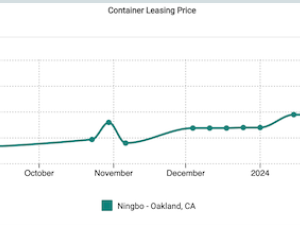The Albany ExpressBarge Service is proving that, with the right partners and the right cargoes, plus a commitment to customer service, inland waterway barge service can successfully be utilized as an intermodal shipping alternative.
Linking the Port of Albany with the Port of New York & New Jersey along a 124-mile stretch of the Hudson River, the service humbly debuted on April 15, 2003, with just one full container aboard.
That container, carrying European tile being imported for Albany Tile Supply, was joined on the Columbia Coastal Transport LLC barge by a few empties, because the barge otherwise would not have looked very good in front of dignitaries attending inaugural voyage ceremonies, according to Tony Vasil, the Port of Albany's marketing representative for the past 18 years.
These days, no such "padding" is necessary. The service is carrying as many as 500 or more containers (mostly of the 40-foot variety) per month. Tile is now joined by supermarket goods on the upriver leg, and export logs on the 16-hour leg down the Hudson. On June 1, service frequency doubled, to twice a week. Value-added services include fumigation of logs, transloading of raw materials from containers to railroad hopper cars, a neutral chassis poll and an empty container pool.
"It has caught on," said Robert F. Krekel, executive vice president of the operations management division of Secaucus, NJ-based COSCO Container Lines Americas Inc. COSCO provides containers for the service. "COSCO took a chance, if you will, to move empties up to Albany, and, right from the get-go, it proved to be a good decision."
As with other inland waterway startups, the Albany service has relied upon government funding and shipper incentives to get going, but Krekel said he believes this particular service has reached a point at which it could be a success even without those incentives.
"Conceptually, the idea is a little hard to swallow in the beginning," Krekel said, citing the much longer travel time for barge than for truck - 16 hours compared with often three hours or less. "Many of our competitors were very skeptical. You need to have some perception, some vision, that by making the initial commitment it will bear fruit."
One of the keys for the Albany ExpressBarge Service has been "the right cargoes," according to Krekel. Both with the import tile and the export logs, containers are maximally loaded to weights often exceeding limits allowed for over-the-road transport.
That factor is not the only one that has proven beneficial, according to Chris S. Kilibarda, assistant vice president of Lebanon, NH-based Global Timber Products Ltd., which typically as a whole exports 150 log-filled 40-foot-long containers per month. The majority of those move via the Albany barge.
"The Port of Albany has bent over backwards to be customer-friendly," Kilibarda said. "It very much helps to have a port that will work with you."
Another factor has been the presence of fumigation facilities at Albany. Such treatment is required for logs heading to China, Global Timber's chief market.
"Our business is strong," Kilibarda said. "Our business into China is exceptionally strong."
Global Timber moves bone-white hard maple and other hardwood logs by truck to Albany from its largest logyard, in Hartland, VT. The 130-mile trip takes three hours because it requires travel along some back roads, according to Kilibarda. Sometimes, he said, cherry logs are brought to the Albany barge from another Global Timber facility some 240 miles away, in Liberty, PA.
The logs have helped the Hudson River service buck an industry trend. Export volumes now make up about 60% of its volumes, according to Vasil. The logs also have proven that barged cargo can be attracted from a greater distance than the 50-mile radius originally projected in the Port of New York & New Jersey Port Inland Distribution Network (PIDN) concept plan.
The plan was drawn up nearly 2 1/2 years before the inaugural voyage. Accord





